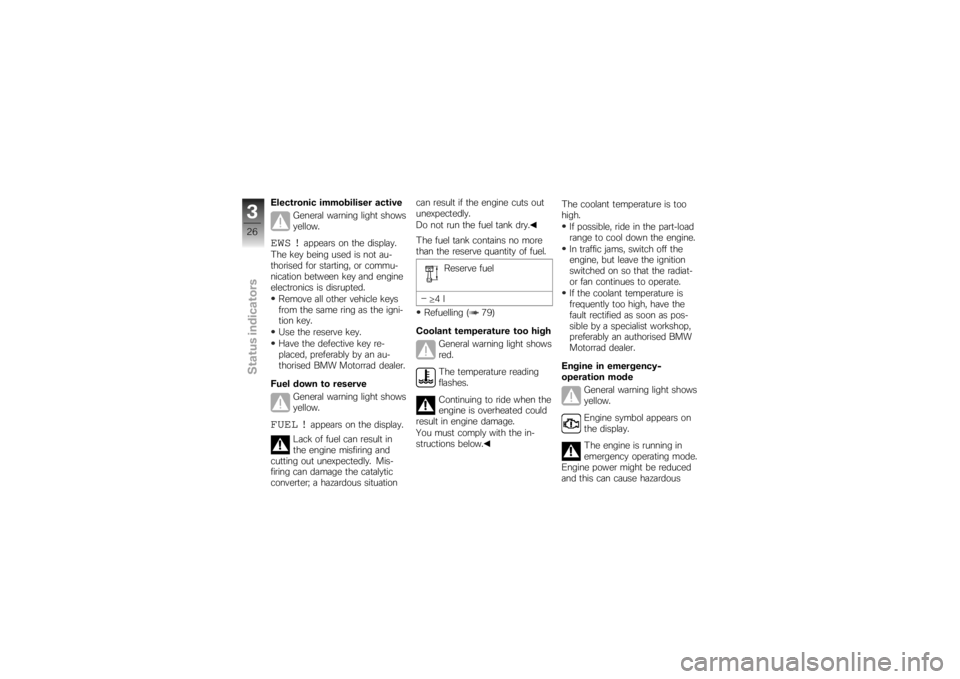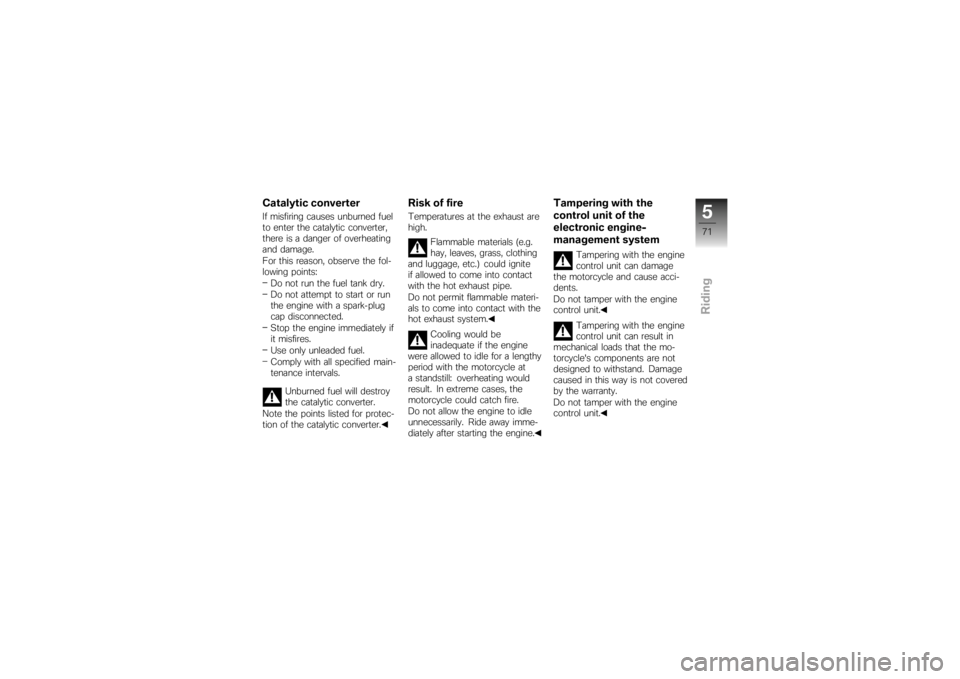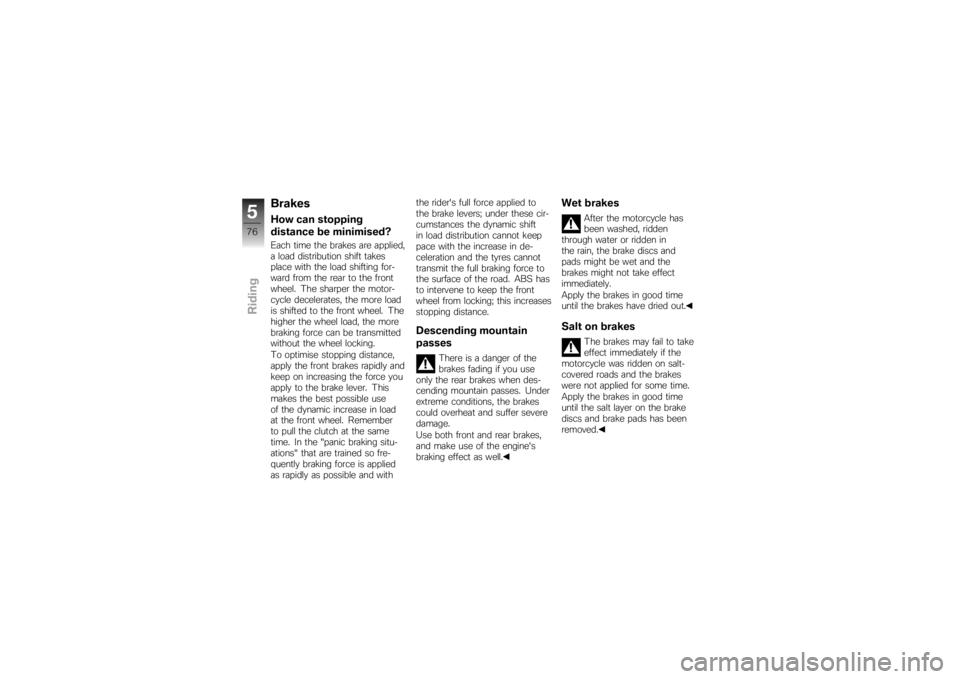engine overheat BMW MOTORRAD K 1200 R 2007 Rider's Manual (in English)
[x] Cancel search | Manufacturer: BMW MOTORRAD, Model Year: 2007, Model line: K 1200 R, Model: BMW MOTORRAD K 1200 R 2007Pages: 168, PDF Size: 2.85 MB
Page 28 of 168

Electronic immobiliser activeGeneral warning light shows
yellow.EWS !
appears on the display.
The key being used is not au-
thorised for starting, or commu-
nication between key and engine
electronics is disrupted. Remove all other vehicle keys
from the same ring as the igni-
tion key.
Use the reserve key.
Have the defective key re-
placed, preferably by an au-
thorised BMW Motorrad dealer.
Fuel down to reserve General warning light shows
yellow.
FUEL !
appears on the display.
Lack of fuel can result in
the engine misfiring and
cutting out unexpectedly. Mis-
firing can damage the catalytic
converter; a hazardous situation can result if the engine cuts out
unexpectedly.
Do not run the fuel tank dry.
The fuel tank contains no more
than the reserve quantity of fuel.
Reserve fuel
≥ 4l
Refuelling ( 79)
Coolant temperature too high General warning light shows
red.
The temperature reading
flashes.
Continuing to ride when the
engine is overheated could
result in engine damage.
You must comply with the in-
structions below. The coolant temperature is too
high.
If possible, ride in the part-load
range to cool down the engine.
In traffic jams, switch off the
engine, but leave the ignition
switched on so that the radiat-
or fan continues to operate.
If the coolant temperature is
frequently too high, have the
fault rectified as soon as pos-
sible by a specialist workshop,
preferably an authorised BMW
Motorrad dealer.
Engine in emergency-
operation mode General warning light shows
yellow.
Engine symbol appears on
the display.
The engine is running in
emergency operating mode.
Engine power might be reduced
and this can cause hazardous
326zStatus indicators
Page 73 of 168

Catalytic converterIf misfiring causes unburned fuel
to enter the catalytic converter,
there is a danger of overheating
and damage.
For this reason, observe the fol-
lowing points:Do not run the fuel tank dry.
Do not attempt to start or run
the engine with a spark-plug
cap disconnected.
Stop the engine immediately if
it misfires.
Use only unleaded fuel.
Comply with all specified main-
tenance intervals.
Unburned fuel will destroy
the catalytic converter.
Note the points listed for protec-
tion of the catalytic converter.
Risk of fireTemperatures at the exhaust are
high.
Flammable materials (e.g.
hay, leaves, grass, clothing
and luggage, etc.) could ignite
if allowed to come into contact
with the hot exhaust pipe.
Do not permit flammable materi-
als to come into contact with the
hot exhaust system.
Cooling would be
inadequate if the engine
were allowed to idle for a lengthy
period with the motorcycle at
a standstill: overheating would
result. In extreme cases, the
motorcycle could catch fire.
Do not allow the engine to idle
unnecessarily. Ride away imme-
diately after starting the engine.
Tampering with the
control unit of the
electronic engine-
management system
Tampering with the engine
control unit can damage
the motorcycle and cause acci-
dents.
Do not tamper with the engine
control unit.
Tampering with the engine
control unit can result in
mechanical loads that the mo-
torcycle's components are not
designed to withstand. Damage
caused in this way is not covered
by the warranty.
Do not tamper with the engine
control unit.
571zRiding
Page 78 of 168

BrakesHow can stopping
distance be minimised?Each time the brakes are applied,
a load distribution shift takes
place with the load shifting for-
ward from the rear to the front
wheel. The sharper the motor-
cycle decelerates, the more load
is shifted to the front wheel. The
higher the wheel load, the more
braking force can be transmitted
without the wheel locking.
To optimise stopping distance,
apply the front brakes rapidly and
keep on increasing the force you
apply to the brake lever. This
makes the best possible use
of the dynamic increase in load
at the front wheel. Remember
to pull the clutch at the same
time. In the "panic braking situ-
ations" that are trained so fre-
quently braking force is applied
as rapidly as possible and withthe rider's full force applied to
the brake levers; under these cir-
cumstances the dynamic shift
in load distribution cannot keep
pace with the increase in de-
celeration and the tyres cannot
transmit the full braking force to
the surface of the road. ABS has
to intervene to keep the front
wheel from locking; this increases
stopping distance.
Descending mountain
passes
There is a danger of the
brakes fading if you use
only the rear brakes when des-
cending mountain passes. Under
extreme conditions, the brakes
could overheat and suffer severe
damage.
Use both front and rear brakes,
and make use of the engine's
braking effect as well.
Wet brakes
After the motorcycle has
been washed, ridden
through water or ridden in
the rain, the brake discs and
pads might be wet and the
brakes might not take effect
immediately.
Apply the brakes in good time
until the brakes have dried out.
Salt on brakes
The brakes may fail to take
effect immediately if the
motorcycle was ridden on salt-
covered roads and the brakes
were not applied for some time.
Apply the brakes in good time
until the salt layer on the brake
discs and brake pads has been
removed.
576zRiding